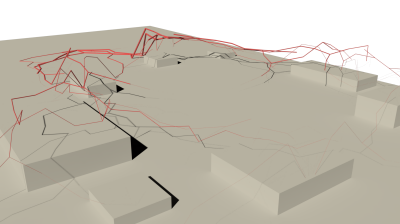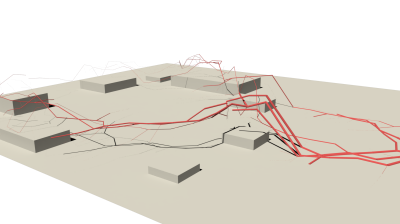Difference between revisions of "project07:W3"
(→Ori Gilboa) |
(→Ori Gilboa) |
||
| Line 17: | Line 17: | ||
<div style="float:left; width: 120px; height 30px; border: 1px solid #aaa; margin-right:10px;" align="center">[[project07:W5|'''W5 ''']]</div> | <div style="float:left; width: 120px; height 30px; border: 1px solid #aaa; margin-right:10px;" align="center">[[project07:W5|'''W5 ''']]</div> | ||
</div> | </div> | ||
| + | |||
| + | |||
| + | [[File:Growimage3.png|400px|thumb|left|]] | ||
For my project of urban-cinema I tried to establish a well connected building which reacts and response to the environment and to its surroundings. It was highly important to allow a parametric, flexible pathways from a central point. A root or a plant may serve as an allegory for this type of branching structure. I was contemplating 3 strategies: Agent-base design (swarm behavior), L-systems and recursive systems. Agent-base design is responsive and can create an elaborate forms, however it is a decentralize system, and has no hierarchy. L systems contain a good thematic branch algorithm and hierarchy - but they are tend to be too rigid and uninfected by the surroundings. Recursive systems respond to the environment - and can have a hierarchy. This was my base strategy for the beginning. | For my project of urban-cinema I tried to establish a well connected building which reacts and response to the environment and to its surroundings. It was highly important to allow a parametric, flexible pathways from a central point. A root or a plant may serve as an allegory for this type of branching structure. I was contemplating 3 strategies: Agent-base design (swarm behavior), L-systems and recursive systems. Agent-base design is responsive and can create an elaborate forms, however it is a decentralize system, and has no hierarchy. L systems contain a good thematic branch algorithm and hierarchy - but they are tend to be too rigid and uninfected by the surroundings. Recursive systems respond to the environment - and can have a hierarchy. This was my base strategy for the beginning. | ||
| Line 26: | Line 29: | ||
Polygon borders: Borders are defined by closed polygons. The branching algorithm avoids going into any of them. For every placed node a check is being made to make sure it is within "safe zone" - if it does, it stays, otherwise - it is deleted. Those borders could be used as the perimeter of the site, open spaces or unapproachable obstacles. | Polygon borders: Borders are defined by closed polygons. The branching algorithm avoids going into any of them. For every placed node a check is being made to make sure it is within "safe zone" - if it does, it stays, otherwise - it is deleted. Those borders could be used as the perimeter of the site, open spaces or unapproachable obstacles. | ||
| − | [[File: | + | [[File:Growimage2.png|400px|thumb|left|]] |
| + | [[File:Growimage1.jpg|400px|thumb|left|]] | ||
Revision as of 16:59, 4 January 2018
Ori Gilboa
For my project of urban-cinema I tried to establish a well connected building which reacts and response to the environment and to its surroundings. It was highly important to allow a parametric, flexible pathways from a central point. A root or a plant may serve as an allegory for this type of branching structure. I was contemplating 3 strategies: Agent-base design (swarm behavior), L-systems and recursive systems. Agent-base design is responsive and can create an elaborate forms, however it is a decentralize system, and has no hierarchy. L systems contain a good thematic branch algorithm and hierarchy - but they are tend to be too rigid and uninfected by the surroundings. Recursive systems respond to the environment - and can have a hierarchy. This was my base strategy for the beginning.
I planned the algorithm according to 3 layers:
base branching: The branching starts from a central point. It has a certain direction (generated from a field of randomness) and characteristic: number of nodes (or branching points), length of branches, minimum distances from one node to the other.
Polygon borders: Borders are defined by closed polygons. The branching algorithm avoids going into any of them. For every placed node a check is being made to make sure it is within "safe zone" - if it does, it stays, otherwise - it is deleted. Those borders could be used as the perimeter of the site, open spaces or unapproachable obstacles.

